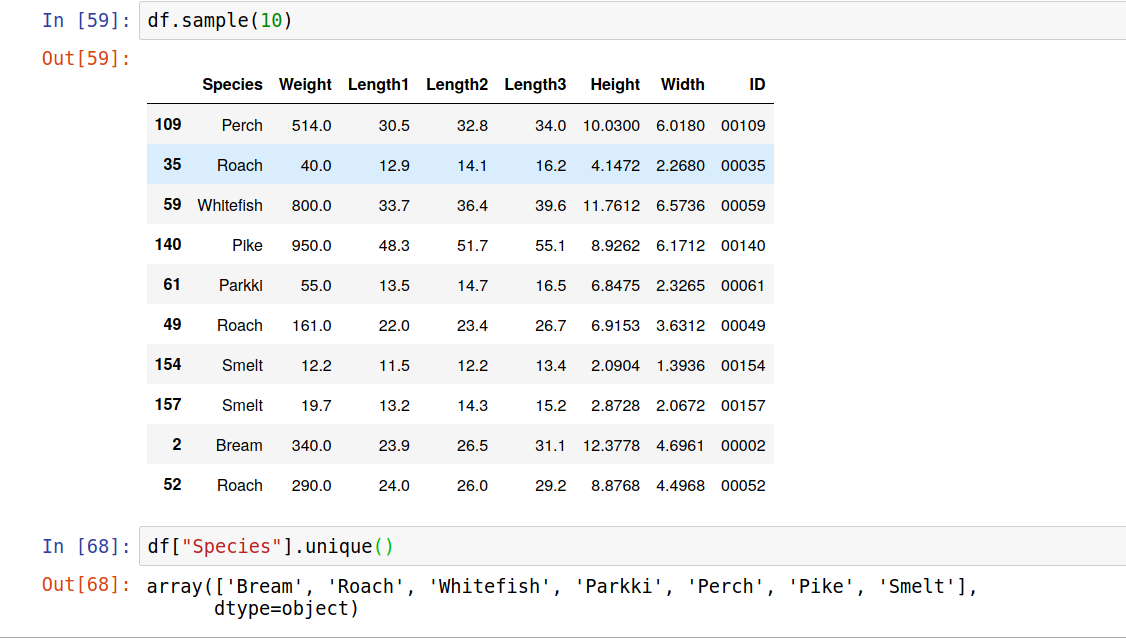Klasifikace #
Zatím jsme se zabývali jen regresními úlohami. Učení s učitelem ale zahrnuje dvě hlavní skupiny úloh - regresní úlohy a klasifikační úlohy.
Zatímco u regresních úloh je výstupem modelu spojitá hodnota (float), v klasifikačních úlohách představuje výstup modelu indikátor třídy (label).
Držme se našeho rybího trhu a ukažme si to na příkladu. Úloha predikovat váhu ryby byla regresní úloha, predikovali jsme spojitou hodnotu. Pokud budeme chtít predikovat druh ryby (Perch - okoun, Roach - plotice, Pike - štika, ...), jedná se o predikci kategorické hodnoty, tedy o klasifikaci.
Klasifikační úlohy mají trochu jiné vlastnosti a logiku, než úlohy regresní, proto existují modely přímo určené na takové úlohy. Říká se jim klasifikátory.
Zkusíme se ale nejdřív podívat na úlohu klasifikace z pohledu, který už známe, tedy z pohledu krajiny.

# načeteme si data
import pandas as pd
import numpy as np
np.random.seed(2020) # nastavení náhodného klasifikátoru
data = pd.read_csv("static/fish_data.csv", index_col=0)
data
Úkol 1: #
Nejčastějším druhem ryby je Perch (okoun). Naším cílem je vytvořit klasifikátor, který pro zadané míry (váha, různé délky a šířky) vrátí informaci, zda se jedná o okouna nebo jiný druh. (Máme tedy pro jednoduchost jen dvě třídy, Perch a ostatní.)
Uměla bys tuto úlohu napasovat na krajinu? Co by mohly být souřadnice a co nadmořská výška?
Pokud ses úspěšně poprala s předchozím dotazem, můžeš na klasifikaci použít některý z regresních modelů (ano, asi to nebude ideální, když jde o klasifikaci, ale zkusme nejdříve to, co již umíme). Co ale bude hodnota odezvy a jak ji budeme interpretovat?
Klasifikační modely #
Přinášíme opět nějakou základní nabídku klasifikačních modelů:
-
- n_estimators, integer, optional (default=100)
-
- C, float, optional (default=1.0)
- kernel,string, optional (default=’rbf’)
Úkol 2: #
Vyberete si jeden model a zkuste natrénovat na ryby.
Nejprve připravíme data obdobně jako v minulé hodině. Jako sloupeček odezvy použijeme True pro okouny a False pro ostatní ryby. Sloupeček Species pak už nebudeme potřebovat, stejně tak můžeme vypustit sloupeček ID.
# připravme data
y = data["Species"] == "Perch"
y = y.astype(int)
X = data.drop(columns=["ID", "Species"])
Dalším krokem je rozdělení na trénovací a validační data. Nezapomeňme na stratifikaci.
# rozdělme na trénovací a validační množinu
from sklearn.model_selection import train_test_split
X_train_raw, X_test_raw, y_train, y_test = train_test_split(X, y, stratify=y)
Data přeškálujeme.
from sklearn.preprocessing import StandardScaler
scaler = StandardScaler()
X_train = scaler.fit_transform(X_train_raw)
X_test = scaler.transform(X_test_raw)
Jako model zvolíme rozhodovací strom. Neboj se zkusit jiný klasifikátor dle své volby.
# vezměme klasifikátor
# můžeš změnit
from sklearn.tree import DecisionTreeClassifier
model = DecisionTreeClassifier()
# natrénujte
model.fit(X_train, y_train);
Máme natrénovaný model, jdeme se podívat, jak funguje na validačních datech.
# ohodnoťme validační množinu
pred = model.predict(X_test)
print("Skutečná třída: Predikce:")
for true, predicted in zip(y_test, pred):
print(f"{true:<15} {predicted:<10} {'OK' if true == predicted else 'X'}")
print(f"Počet chyb: {sum(y_test != pred)}")
Úkol 3: #
- Asi je jasné, že regresní metriky se nám na klasifikační úlohy moc nehodí. Co bys použila jako metriku pro klasifikační úlohu?
Úkol 4: #
- Jedna z možností je porovnávat procento úspěšně klasifikovaných vzorů. V našem případě, to bude:
print(f"Úspěšnost: {100*sum(y_test == pred)/len(y_test):.2f} %")
Úspěšnost není úplně špatná, poznat druh ryby podle rozměrů není jendoduchá úloha.
Představ si ale, že budeme mít v datovou množinu se 100 rybami, 95 z nich bude okounů (typu Perch). Bude ti klasifikátor, který bude mít toto procento úspěšnosti (stejné jako vyšlo nám), připadat dobrý nebo ne? Proč?
Úkol 5: #
Nejprve projdeme klasifikační metriky. Pokud studuješ sama, nastuduj si kapitolu o klasifikačních metrikách a pak se vrať k tomuto cvičení.
Vyber si metriku pro naši úlohu a zkus najít, co nejlepší klasifikátor. Pak si načti testovací množinu a podívej se, jaké tvůj klasifikátor dává výsledky.
from sklearn.neighbors import KNeighborsClassifier
from sklearn.tree import DecisionTreeClassifier
from sklearn.ensemble import RandomForestClassifier
from sklearn.svm import SVC
# zkus naučit různé modely a vyber nejlepší
models = {}
# KNeigbors
for N in 1, 3, 5, 7:
models[("nearest neighbors", N)] = KNeighborsClassifier(n_neighbors=N, weights="distance")
# tree
for d in range(3, 20):
models[("tree", d)] = DecisionTreeClassifier(max_depth=d, class_weight='balanced')
# random forest
for N in range(1, 100):
models[("random forest", N)] = RandomForestClassifier(n_estimators=N, class_weight='balanced')
# SVC
for C in range(-2, 10):
models[("SVC", 10**C)] = SVC(C=10**C, class_weight='balanced')
Vytvořili jsme si slušnou zásobu modelů, uložili jsme je do slovníku. Každý model máme pro různé hodnoty příslušného hyper-parametru.
models
Obdobně jako v minulé hodině vytvoříme funci, která ohodnotí model a vrátí hodnoty vybrané metriky na trénovací a validační množině. Hodnoty vrací ve slovníku (což nám pak umožní snadnější vytvoření dataframu s výsledky).
from sklearn.metrics import f1_score
from sklearn.metrics import confusion_matrix
def train_and_eval(X_train, X_test, y_train, y_test, model):
model.fit(X_train, y_train)
y_pred_test = model.predict(X_test)
y_pred_train = model.predict(X_train)
return {"train": f1_score(y_train, y_pred_train), # metriku můžeš vyměnit za nějakou svojí
"test": f1_score(y_test, y_pred_test)
}
results = []
for name, model in models.items():
res = train_and_eval(X_train, X_test, y_train, y_test, model)
res["model"] = name[0]
res["param"] = name[1]
results.append(res)
df_results = pd.DataFrame(results)
df_results
Závislost úspěsnosti modelu (dle zvolené metriky) na hodnotě příslušného hyperparametru si zobrazíme v grafu.
import seaborn as sns
import matplotlib.pyplot as plt
def zobraz_model(model_name, ax, logx=False):
sns.lineplot(x="param", y="train", data=df_results[df_results["model"]==model_name], label="train", ax=ax)
sns.lineplot(x="param", y="test", data=df_results[df_results["model"]==model_name], label="test", ax=ax)
ax.set_title(model_name.capitalize())
if logx:
ax.set(xscale="log")
fig, axs = plt.subplots(ncols=4, figsize=(16,4))
zobraz_model("nearest neighbors", axs[0])
zobraz_model("tree", axs[1])
zobraz_model("random forest", axs[2])
zobraz_model("SVC", axs[3], logx=True)
Úkol 6: #
Vyber si model, který se na validační množině jeví jako nejlepší. Vyzkoušej jej na testovací data.
# načtení data
test_data = pd.read_csv("static/fish_data_test.csv", index_col=0)
y_real_test = test_data["Species"] == "Perch"
y_real_test = y_real_test.astype(int)
X_real_test = test_data.drop(columns=["ID", "Species"])
X_real_test = scaler.transform(X_real_test)
# predikce
model = models[("SVC", 10**4)]
test_pred = model.predict(X_real_test)
# zkus přidat zvolenou metriku
print(f"Skutečná třída: Predikce:")
for true, predicted in zip(y_real_test, test_pred):
print(f"{true:<15} {predicted:<10} {'OK' if true == predicted else 'X'}")
print(f"Počet chyb: {sum(y_real_test != test_pred)}")
print(f"Úspěšnost: {100*sum(y_real_test == test_pred)/len(y_real_test):.2f} %")